Related Research Articles

A teapot is a vessel used for steeping tea leaves or a herbal mix in boiling or near-boiling water, and for serving the resulting infusion which is called tea. It is one of the core components of teaware. Dry tea is available either in tea bags or as loose tea, in which case a tea infuser or tea strainer may be of some assistance, either to hold the leaves as they steep or to catch the leaves inside the teapot when the tea is poured. Teapots usually have an opening with a lid at their top, where the dry tea and hot water are added, a handle for holding by hand and a spout through which the tea is served. Some teapots have a strainer built-in on the inner edge of the spout. A small air hole in the lid is often created to stop the spout from dripping and splashing when tea is poured. In modern times, a thermally insulating cover called a tea cosy may be used to enhance the steeping process or to prevent the contents of the teapot from cooling too rapidly.
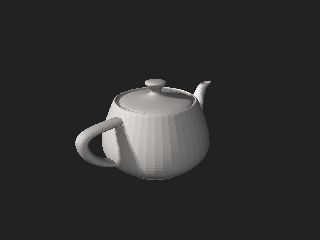
The Utah teapot, or the Newell teapot, is a 3D test model that has become a standard reference object and an in-joke within the computer graphics community. It is a mathematical model of an ordinary Melitta-brand teapot that appears solid with a nearly rotationally symmetrical body. Using a teapot model is considered the 3D equivalent of a "Hello, World!" program, a way to create an easy 3D scene with a somewhat complex model acting as the basic geometry for a scene with a light setup. Some programming libraries, such as the OpenGL Utility Toolkit, even have functions dedicated to drawing teapots.
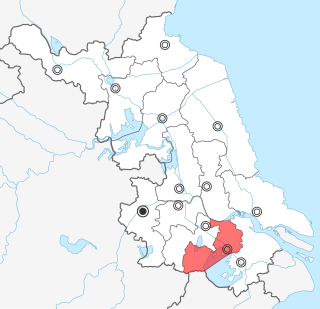
Wuxi is a city in southern Jiangsu province, eastern China, 135 kilometers (84 mi) by car to the northwest of downtown Shanghai, between Changzhou and Suzhou. In 2017 it had a population of 3,542,319, with 6,553,000 living in the entire prefecture-level city area. By the end of 2019, the city's registered population was 5.0283 million.

Yancheng is a prefecture-level city in northeastern Jiangsu province, People's Republic of China. As the city with the largest jurisdictional area in Jiangsu, Yancheng borders Lianyungang to the north, Huai'an to the west, Yangzhou and Taizhou to the southwest, Nantong to the south, and the Yellow Sea to the east. Formerly a county, the current Yancheng city was founded on January 18, 1983.

Teaware is a broad international spectrum of equipment used in the brewing and consumption of tea. Many components make up that spectrum, and vary greatly based upon the type of tea being prepared, and the cultural setting in which it is being prepared. This is often referred to as the tea ceremony, and holds much significance in many cultures, particularly in northwestern Europe and in eastern Asia. A complete, cohesive collection of tea ware makes up a tea set.

The Hyper Text Coffee Pot Control Protocol (HTCPCP) is a facetious communication protocol for controlling, monitoring, and diagnosing coffee pots. It is specified in RFC 2324, published on 1 April 1998 as an April Fools' Day RFC, as part of an April Fools prank. An extension, HTCPCP-TEA, was published as RFC 7168 on 1 April 2014 to support brewing teas, which is also an April Fools' Day RFC.
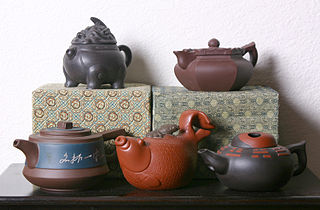
Yixing clay is a type of clay from the region near the city of Yixing in Jiangsu Province, China, used in Chinese pottery since the Song dynasty (960–1279) when Yixing clay was first mined around China's Lake Tai. From the 17th century on, Yixing wares were commonly exported to Europe. The finished stoneware, which is used for teaware and other small items, is usually red or brown in colour. Also known as zisha (宜興紫砂) ware, they are typically left unglazed and use clays that are very cohesive and can form coils, slabs and most commonly slip casts. These clays can also be formed by throwing. The best known wares made from Yixing clay are Yixing clay teapots, tea pets, and other teaware.
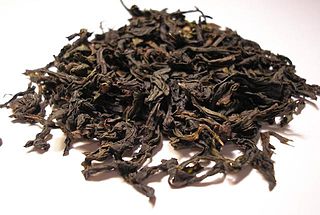
Da Hong Pao is a Wuyi rock tea grown in the Wuyi Mountains of Fujian Province, China. Da Hong Pao has a unique orchid fragrance and a long-lasting sweet aftertaste. Dry Da Hong Pao has a shape like tightly knotted ropes or slightly twisted strips, and is green and brown in color. After brewing, the tea is orange-yellow, bright and clear. Da Hong Pao can retain its flavor for nine steepings. The tea is often known to be extremely expensive.

A tea set or tea service is a collection of matching teaware and related utensils used in the preparation and serving of tea. The traditional components of a tea set may vary between societies and cultures.
Joan Takayama-Ogawa is a sansei (third-generation) Japanese-American ceramic artist and currently professor at Otis College of Art and Design in Los Angeles, California. Takayama-Ogawa's heritage since the 15th century of Japanese ceramic art influences her work, that usually explores beauty, decoration, ornamentation and narrative while also introducing a dialogue that rejects the traditional role of women in Japanese culture. Her most recent work addresses issues like climate change.

Yixing clay teapots, also called Zisha teapot, are made from Yixing clay. This traditional style commonly used to brew tea originated in China, dating back to the 15th century, and are made from clay produced near Yixing in the eastern Chinese province of Jiangsu.

Chen Jiru was a Chinese landscape painter, calligrapher and essayist during the Ming dynasty (1368–1644).

A ceramics museum is a museum wholly or largely devoted to ceramics, usually ceramic art. Its collections may also include glass and enamel, but typically concentrate on pottery, including porcelain. Most national collections are in a more general museum covering all of the arts, or just the decorative arts. However, there are a number of specialized ceramics museums, with some focusing on the ceramics of just one country, region or manufacturer. Others have international collections, which may be centered on ceramics from Europe or East Asia or have a more global emphasis.
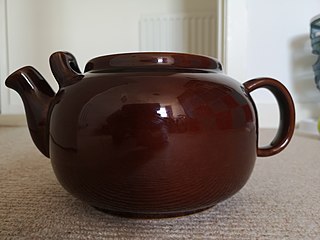
A Brown Betty is a type of teapot, round and with a manganese brown glaze known as Rockingham glaze.
Yixing Factory Number One is the oldest teapot factory in China. The factory houses skilled artisans who set strict standards for their work.

Tea Pet or Tea Lover's Pet, also known as Chachong, is a small pottery figure which is kept by some tea drinkers for good luck. They are usually made of "zisha" or Yixing clay, from the region near Yixing in Jiangsu province, China. Similar to Yixing teapots made from the same clay, tea pets are unglazed, and are mostly monochromatic with a rough surface.
Gu Jingzhou simplified Chinese: 顾景舟; traditional Chinese: 顧景舟; pinyin: Gù Jǐngzhōu was a Chinese ceramic artist who specialised in the creation of zisha-ware teapots. He was a founder and Deputy Director of Research and Technology at the Number One Yixing Factory.
Nan Bangs McKinnell (1913–2012) was an American ceramicist and educator. Nan was a founding member of the National Council on Education for the Ceramic Arts, a member of the American Craft Council College of Fellows, along with receiving several awards for her work. James "Jim" McKinnell (1919–2005), her spouse, was also a ceramicist and they made some collaborative work.
Xu Sihai was a Chinese teapot creator, artisan, collector, and curator. Xu was an expert and authority on purple clay teapots, also known as the Yixing clay teapot. In 1992, Xu founded the Sihai Teapot Museum, the first private museum established in modern Shanghai.
Teapot may refer to: